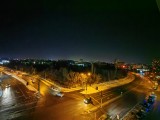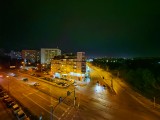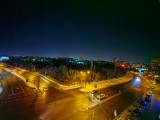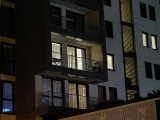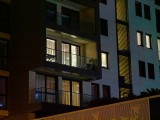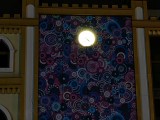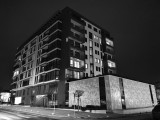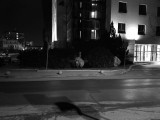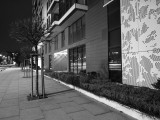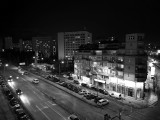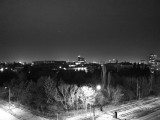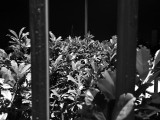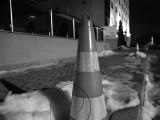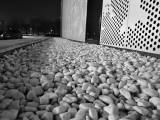Huawei P50 Pro review

The latest Leica-powered camera
The Huawei P series, since the P10, has been famous for its Leica-powered cameras, and the P50 Pro is no different. The P10 and P20 introduced monochrome cameras, absent on the P30 and P40 series, but the B&W camera is now returning with the P50 Pro. We also get three more cameras - a regular wide-angle, an ultrawide-angle, and a two-step telephoto. Oh, and an ultrawide-angle selfie with autofocus!

So, the Huawei P50 Pro features a 50MP main camera (probably OmniVision OV5A 1/1.56" with a Quad-Bayer filter) behind a 23mm (27mm per the EXIF) f/1.8 OIS lens. PDAF and Laser AF assistance is available here. The camera saves 12.5MP photos, but 50MP and 50MP AI modes are available.
Second is the 13MP camera with a 13mm f/2.2 lens for ultrawide-angle photos. AF is available, too, so you can take closeup shots with it as well.
Third is the 40MP monochrome camera, meaning the sensor omits a Bayer color filter, which should allow light to reach the sensor more easily and with higher quality. Its field-of-view is the same as the main camera's and it has autofocus. Besides allowing great high-contrast moody B&W shots, its input is also used to reduce the noise and enhance clarity when shooting with the other cameras as well. This camera saves 12.5MP photos, and there is no way to get the native 40MP output.
Finally, the last rear camera is the 64MP zoom snapper. The sensor has a proper Bayer filter instead of the widespread Quad-Bayer ones. It has a 90mm (95mm per EXIF) f/3.5 OIS periscopic lens for 3.5x optical zoom over the main camera. This camera takes 16MP pixel-binned photos, but it can also provide up to 7x lossless zoom by cropping from the 64MP sensor. Huawei has two fixed presets in the camera app - 3.5x and 10x.
There is a dual-LED flash, Laser emitter and receiver that help the autofocus, as well as a multispectral color temperature sensor for better color reproduction and white balance across all rear cameras.
The selfie camera is quite interesting, too. It has a 13MP sensor behind an 18mm f/2.4 lens, and phase-detection autofocus is available! You choose between three crop modes - wide-angle (18mm, no crop), 0.8x (21mm equiv.) and 1x (27mm equiv.).

The camera app has hardly changed since previous Huawei phones. You have a Mode selector on the bottom, which you can swipe left or right to change modes. You can add more options on this bar, too.
Zooming has been fixed since the P50, and the selector is now where it should be - at the bottom in portrait and to the left in landscape orientation. It has four fixed steps - UW, 1x, 3.5x and 10x. You can use other zoom levels by swiping on the zoom bar, of course.
The camera app is enhanced by Huawei's AI, just as before. There is an improved Master AI, which recognizes and tunes settings for a ton of scenes. There's a toggle in the viewfinder for turning it off and on, so you don't have to go into settings for that. We tend to keep it off, although the recent implementations are nowhere as aggressive as they used to be with phones in the past.

There's a Pro mode too where you can adjust parameters yourself - ISO (50 to 409,600), shutter speed (1/4000s to 30s), exposure compensation (-4 to +4EV in 1/3 stop increments), and white balance (presets and specific light temperature). You can also choose the metering mode (matrix, center-weighted, and spot), and the focus mode (single, continuous, and manual). If the phone thinks you messed up the exposure, an icon will pop up to warn you. Mind you, Pro mode is available on all rear cameras.
By the way, Pro mode is available for video as well, and the maximum ISO there is 6,400. And you can set the desired shutter speed.
For years now, Huawei phones have had both a Portrait mode and an Aperture mode. In Aperture, you can choose the simulated aperture in the range from f/0.95 to f/16. Post shot, you can change the aperture and the desired focus point within the Gallery.
Finally, there are three Leica filters, in addition to many Huawei ones. Well, actually two as Leica standard is the standard shooting mode across all cameras (meaning no filter). The rest are Leica Vivid and Leica Smooth - as always.
Photo quality
The main camera (1x) saves 12.5MP photos by default, and they are simply outstanding! The resolved detail is abundant, there is no noise, and the processing offers just the right amount of sharpening, giving the images a balanced and natural look. Huawei is usually gentler with the sharpening than most of its competitors, and we really like the samples we shot in broad daylight.
The photos exhibit excellent contrast, the colors are lively and true to life, while the dynamic range is nothing short of impressive.
Overall, the photos from the main camera are among the best we've seen from a smartphone and worthy of the Huawei P and Leica branding.
Important: If you inspect the photos up close, you will notice that some of them have their left parts blurred. It appears that our unit has an odd lens issue (it happens sometimes), which should not be present on other P50 Pro phones, and we will not take it into account when commenting on the quality. Usually, if you experience such lens issues, you need to talk with an authorized service center for repair or replacing the device.
There is a dedicated high-res mode within the camera app, and it offers two choices - 50MP and 50MP AI. The default 50MP option saves upscaled versions of the 12.5MP images, and they are of no use.
The 50MP AI was once called AI Ultra Clarity, and like the Night Mode, it requires a couple of seconds to capture a few 50MP images and stack them together. The 50MP AI samples are more detailed than the standard 50MP ones, but if downsized to 12.5MP, they won't be better than the default ones, on the contrary. And that's why we think no one will use either of these 50MP options - there are simply no benefits.
The main camera is also the primary portrait shooter, and it does a brilliant job. The 12.5MP portraits (1x zoom) we took with it offer proficient subject separation and natural-looking blur, while the subjects remain detailed and sharp. The colors and the dynamic range and quite good, too.
There are more zoom levels within the Portrait mode (2x, 3x), but they provide digital zoom over the main camera and save pretty soft portraits.
The ultra wide-angle camera supports autofocus that allows it to shoot macro photos, too. There is a downside to it, though, sometime the focus won't lock properly on infinity and will result in soft images. You can spot a few occasions in the batch below.
The inaccurate focus aside, the 13MP ultrawide camera is quite capable and produces detailed and sharp enough photos. The automatic corner straightening is impressively proficient, too.
Just like the main photos, the ultrawide ones also offer excellent contrast, colors and great dynamic range.
This is definitely one of the better UW cameras we've met in a while, and it does save commendable panoramic photos. Our advice is to tap often around the center before taking a picture so you can avoid out-of-focus images.
Shooting a macro photo with the ultrawide camera is possible and quite easy. Usually, those are detailed, sharp, contrasty, and preserved color saturation. We found the closeups with the primary camera to be somewhat better, though because of the more natural bokeh and often more detailed center, so you may want to try and see what looks nicer to you.
The zoom camera on the Huawei P50 Pro is incredibly interesting. It uses a normal 64MP sensor with 90mm OIS lens, and it provides about 3.5x zoom over the main camera. The photos are saved in 16MP resolution.
But this camera can also achieve lossless zoom by just cropping from the center of the original 64MP image. This means when the algorithm crops the 16MP center of the 64MP output, it should be equivalent to 180mm or 7x zoom over the main camera.
So, to achieve the 10x magnification, the algorithm crops even more (say, 10MP-12MP) and then upscales it back to 16MP - which will lead to some loss of detail and reduce the sharpness.
Let's start with the 3.5x zoomed photos - it's the third fixed step on the zoom bar. Well, those are exceptional. The resolved detail is notably high, there is no visible noise, the contrast is great, the colors are accurate, and the dynamic range is superb. The foliage, where available, looks awesome.
The best thing about these zoomed images is their natural look - they have just the right amount of sharpness applied with nothing over the top. It's rare to see such well-balanced photos, so kudos to Huawei!
The final fixed step on the viewfinder is 10x. As we established, these aren't lossless, but they should still be good enough.
The 10x photos are better than the 10x on the Huawei P40 Pro (upscaled and cropped from 5x) and not that worse from native 10x images we've seen from the Huawei P40 Pro+ and the Galaxy S21 Ultra. In fact, if we downsize these to 8MP, they would look excellent.
Of course, the P50 Pro saves the 10x pictures in 12.5MP photos, and they do look a bit upscaled - you can see the average detail and the lack of sharpness. They do excel in everything else - white balance, contrast, dynamic range, noise reduction.
So, despite the hoops and loops the phone goes through to deliver these 10x photos, they are perfectly usable and look great on the phone's display, our monitors, and even when cast on the larger HDTV screen. For pixel peeping, they could use some downscaling to say, 6MP-8MP.
Finally, we shot a few samples at about 7x zoom - the maximum that can be considered lossless. They all look sharp and lively, even if not as sharp as the 3.5x ones. As usual, they are nicely balanced, and we can only say good things about them.
The 40MP monochrome camera saves 12.5MP photos - it seems Huawei wanted to match the resolution of the main camera, and that's fine. There is no option to save the native 40MP image, though.
The photos we took with the B&W camera are stunning - the detail level is magnificent, the contrast is amazing, and the dynamic range in most scenes is jaw-dropping. Noise, of course, is absent.
If you are a fan of monochrome pictures, there is hardly another current smartphone to take better B&W photos.
Huawei was one of the Night Mode pioneers, but it appears the technology has evolved, and we don't need it anymore. Don't worry, it's still present, and it can always brighten your nighttime photos, should you want that.
It's just that the default nighttime photos out of the main camera are brilliant without it. The detail is plenty, the exposure is excellent, and so is the dynamic range. Blown highlights are a rare occurrence, while the shadows are natural-looking.
The color saturation is outstanding, the noise is incredibly low, and once again, the images offer a very natural look with spot-on sharpness. These regular (probably heavily multi-stacked, of course) photos are among the best we've seen lately, and no Night Mode was needed to take them.
Night Mode, of course, is available, and it takes 1s to shoot and another second to save the photo. The difference between the regular and NM samples is minimal if any. Usually, the Night Mode brightens some shadows and the skies while fixing clipped highlights (if there were any). Sometimes it may over-saturate the colors and give them somewhat an artificial look.
The 13MP ultrawide photos we took at night are incredible for such type of camera. Sure, they are a bit soft, but the noise reduction has done an amazing job, and the colors are accurate and punchy, the contrast is good, and so is the exposure.
Unlike other ultrawide shooters, which we usually label as usable, this one is great (among its kind) and deserves praise. And it gets even more points for taking these images without Night Mode.
Speaking of Night Mode, you can use it on the ultrawide camera, but we can barely see any difference. It takes 1s and may or may not pop the colors, usually the skies and lights, and that's about it.
We think the camera app already does some sort of a Night Mode-like processing, even if for a shorter (than 1s) time. And you can see for yourself it's not just adequate, it's great. And that's why we see no reason to manually opt for the Night Node, no matter which camera you are using - primary or ultrawide. Master AI was off all the time, in case you were wondering.
The telephoto camera takes good photos at 3.5x zoom; that is when the camera app decides on using it. Just like it happens on other phones, that's not always the case (fourth and sixth photos are digital zoom over the main camera).
So, the images taken with the actual tele camera are sharp enough with adequate detail levels, with notably low noise, good exposure and very good contrast, and they all retain excellent color saturation.
The Night Mode worked the same way - used the zoom camera for all but number 4 and 6. Sometimes it improves on the sharpness and colors, but only if necessary - meaning once again we can't see many benefits of using the Night Mode and holding your hand for up to 5 seconds this time.
The 10x photos are always shot on the telephoto camera, and they are actually alright; just don't look at them at full resolution - they are not that detailed even if low on noise (remember, they are upscaled from the 7x or so).
Just like the 3.5x photos, the 10x offer good exposure and superb colors. If you really need to zoom at that far at night, the camera will do a surprisingly good job, probably better than most if not all smartphones so far.
Night Mode is available at 10x zoom, too, and you guess that right, it takes pretty much the same-looking photos as the regular shooting mode. Rarely it can do for improved sharpness and brightness and even more popping colors.
The monochrome camera omits a Bayer filter, and this means more light can reach the sensor. More light also means less noise and better sharpness. This camera comes with a bright f/1.6 lens, too. And the photos it saves at night are top-notch with a balanced look, plenty of detail, and admirable contrast.
The dynamic range is lower than expected as there are many clipped highlights - probably due to the combination of bright lens, no Bayer filter and less image stacking. We don't mind that, in fact, it's probably the desired effect for more dramatic photos.
And here are photos of our usual posters taken with the Huawei P50 Pro. You can see how it stacks up against the competition. Feel free to browse around and pit it against other phones from our extensive database.



Huawei P50 Pro against the Xiaomi Mi 11 Ultra and the Samsung Galaxy S21 Ultra 5G in our Photo compare tool
Reader comments
- Anonymous
- 12 Sep 2023
- r3c
Looking forward
- YUKI93
- 23 Oct 2022
- RII
Looking back at this phone's camera performance, I only noticed just now on how utterly brilliant the zoom photos are. I expect to see the usual oversharpened effect, but I'm not seeing one at all. Heck, I even dare to say that it's No...






































































































































































